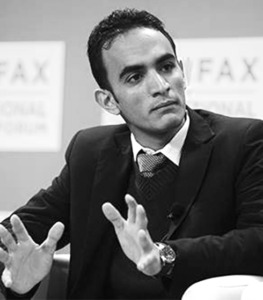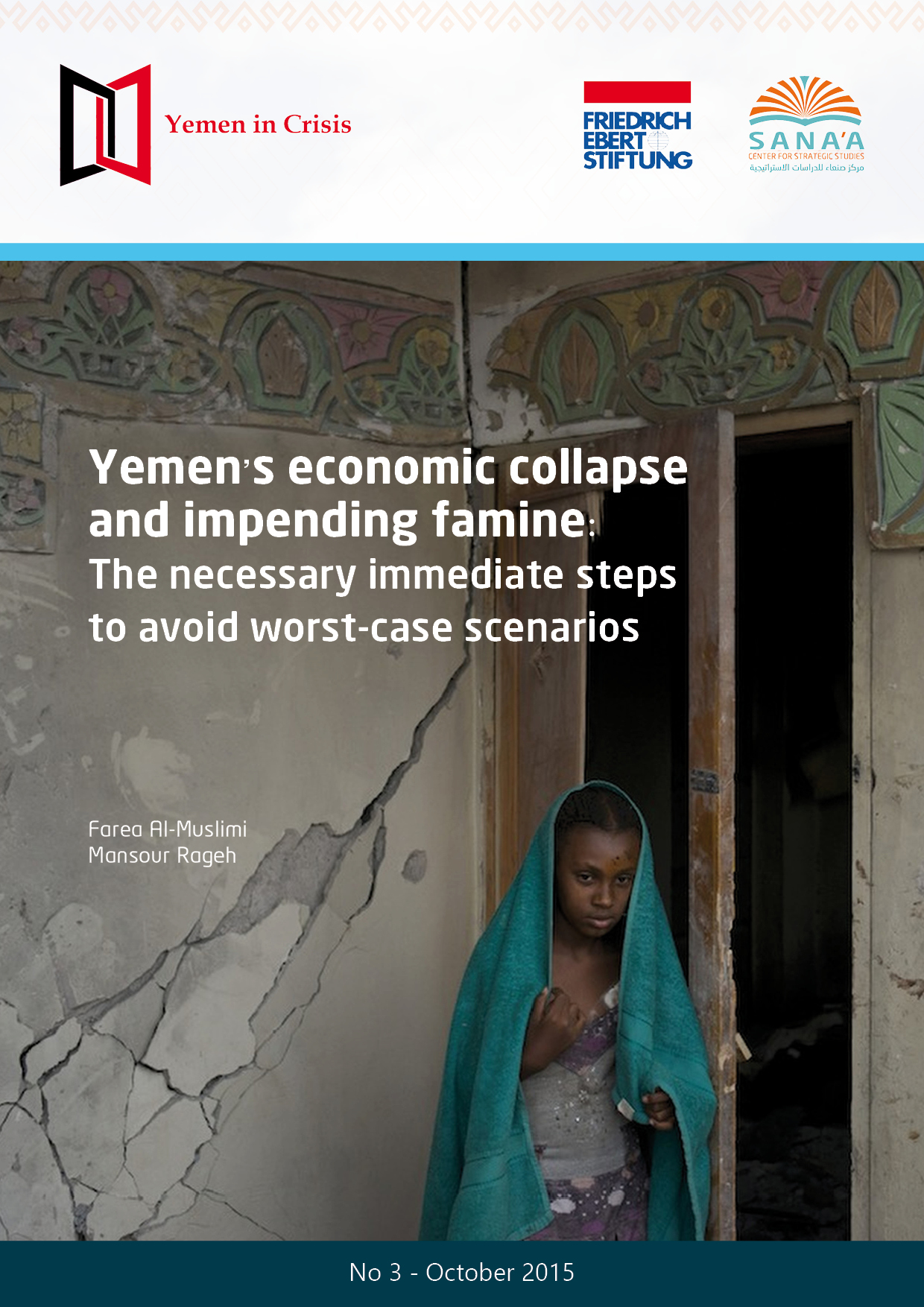Overview
As a result of ongoing civil war and the Saudi-led military intervention, normal economic activity in Yemen has ground to a halt and the country now faces the real prospect of famine. Revenues from oil exports, which previously accounted for roughly 70% of Yemen’s national budget, have stopped completely. The country’s electricity production has become anaemic, which, coupled which a nationwide fuel shortage, has led to dozens of major factories and hundreds of smaller ones closing down, putting hundreds of thousands of people out of work. Most foreign companies and international organizations have suspended operations and have withdrawn both capital and personnel.
Yemeni purchasing power is vanishing in concert with the skyrocketing cost of imports, a disaster in a country that imports 90% of its citizens’ food requirements. Even before the Saudi-led military intervention began in March 2015, the World Bank was reporting that just over half of all Yemenis were living in poverty and that 45% were food insecure; today there are nationwide shortages of all basic commodities and more than six million people are at risk of starvation.
This policy paper, published by the Sana’a Center for Strategic Studies in partnership with the Friedrich-Ebert Foundation, aims to provide a reading of Yemen’s current economic situation. It offers a contemporary context to the crisis, examines the economic impact of the ongoing civil war and Saudi-led military intervention, then discusses policy recommendations for stakeholders regarding how best to prevent the disintegration of Yemen’s economy and the onset of famine.
Economic context to the current conflict
Roughly 70% of Yemen’s 26 million people live in rural areas. Though farming and herding have made up less than 10% of GDP in recent years, they are the source of livelihood for roughly half of the population . Agricultural production, and rural areas generally, are woefully underdeveloped, having received scant central government or private sector investment. In 2012 total public expenditure in rural areas was 4.8% of GDP. Other impediments to development in recent decades have included various civil conflicts, localized insurgencies and a general absence of security and rule of law across large swathes of the country, as well as rampant corruption at all levels of government (in 2014 Yemen ranked 161 out of 175 countries in Transparency International’s global Corruption Perceptions Index). Among the results are that almost none of rural Yemen is connected to the national electricity grid, and roughly 13 million of Yemen’s rural residents have no access to clean drinking water.
Saudi Arabia and coalition countries must broaden and accelerate the entry of humanitarian aid into Yemen, especially medical aid, to allow hospitals and healthcare centers to resume essential services.
All this has fueled a considerable internal migration from rural to urban areas in recent years. The urban population grew by an average annual rate of 4.8% between 2010 and 2015 , taxing the already-stretched provision of public services in the cities, such as water and electricity. (This population transfer has reversed since the Saudi-led military intervention began, however, with the coalition’s bombing campaign in the cities and ground fighting displacing more than 2 million people to date, with most of these fleeing the cities to villages in the countryside, where there is now even less service provision than there was previous to March 2015.)
While Yemen’s educational system has seen small improvements in the last decade, it is still inadequate, with an overall illiteracy rate of 35% for males and 69% for females. Higher education is generally, financially speaking, out of the question for most Yemenis. Until the recent war, however, there had been a small but growing urban middle-and-upper-middle class segment of society which could access the university system, with 265,000 Yemenis enrolled in postsecondary education in 2010. Despite this ostensibly positive indicator, the postsecondary system has been fraught with challenges. Limited regulation has led to a proliferation of private universities – 18 were in operation as of the end of 2014 – with observers suggesting the quality of education offered by many of these degree programs has been dubious at best. These private institutions, along with Yemen’s nine public universities, have also been churning out graduates at a rate outpacing labor market demand. General unemployment hovered around 30% in 2014, and Yemen has one of the fastest population growth rates in the world. The lack of employment opportunities at home has spurred many Yemenis to seek employment abroad, with some 2 million working in neighboring Saudi Arabia alone.
The state’s public sector is phenomenally bloated and its hiring strategies highly politicized, with the public service’s role in ‘serving the public’ matched, if not effectively exceeded, by its role as a vehicle for sprawling patronage networks and clientelism. This was on display in 2011 when, facing mounting public protests spurred by widespread economic hardship and joblessness, then-President Saleh announced in a speech that the next day he would hire 60,000 new government workers, without specifying what they would be employed to do. There are few reliable statistics for how many ‘ghost employees’ exist in the public service – workers receiving government salaries who either do not exist or who do report to work – but anecdotal evidence suggests the number is in the tens of thousands in the civil service alone.
The Ministry of Civil Service stated in 2012 that roughly one million Yemenis were receiving salaries through the various public sector agencies . In Yemen’s 2014 national budget of some US$13.4 billion, public sector wages accounted for roughly US$5 billion, or 37% – the largest single government expenditure – though the vast majority of workers’ take-home salaries effectively translated to subsistence living. This can be attributed to static public sector wage rates for the last decade in a country that has experienced average annual inflation of 11% between 2006 and 2014 (though within that time actual inflation rates have varied wildly, from highs around 25% to lows of less than 1%), while the Yemeni riyal has lost a quarter of its value relative to the US dollar over the same period. The riyal would likely have experienced a much steeper decline in value were it not for several major, and costly, interventions by Central Bank of Yemen (CBY).
International actors must end the coalition’s stranglehold on Yemen’s ports.
Among the threats to Yemen’s currency is the government’s dependence on hydrocarbon revenues to stock its US dollar reserves and its failure to invest in economic diversification. This has left the economy exposed to risks both at home and abroad. In the first quarter of 2009 Yemen’s revenue from oil exports dropped 75% in the wake of the 2008 global financial crisis, and investments to expand energy sector production disappeared. The government took no meaningful steps to rebalance its sources of revenue, and in 2011 its exposure to the energy sector was revealed again, this time when insurgent groups in the country repeatedly sabotaged oil pipelines, forcing the government to draw on its foreign currency reserves to pay for oil imports to cover domestic demand.
Those attacks occurred in tandem with the 2011 Yemeni revolution, when sustained public protests for more than a year had the effect of, among other things, derailing much economic activity and the country’s gross domestic product shrivelled by almost 13%. Due in large part to Saudi Arabia providing a $3 billion injection of cash and fuel in 2012, in 2013 Yemen’s GDP began to make up lost ground, growing 4.8%, with total economic activity reaching near US$36 billion . Despite this growth, generalized fuel subsidies and the public sector wage bill – which together made up well over half of government spending in 2013 – led to the government running a budget deficit of 8% of GDP and helped drain $1 billion from the country’s foreign currency reserves . The Houthi rebels with support from forces loyal to former President Ali Abdullah Saleh took over the capital in September 2014, helping to sink the expected economic growth to 2% for that year.
That takeover was itself, in many ways, prefaced on economic issues. The generalized fuel subsidies have long been the second largest – though most contentious – government budget expenditure, which in 2012 amounted to roughly two-thirds of Yemen’s revenue from oil exports. In July 2014, on the advice of the International Monetary Fund to bring public expenses under control, President Abdo Rabbu Mansour Hadi’s administration announced that it would repeal most of the fuel subsidy. This was projected to raise the cost of petrol roughly 50%, though the impact on the poorest segments of society was to be offset by a simultaneous expansion of the Social Welfare Fund. In reality petrol prices doubled overnight, while the increased social support never materialized. The Houthi Movement, whose military forces had already been encroaching on the capital, seized upon this to gain a populist agenda and legitimacy, staging demonstrations to protest what it said were the government’s economic injustices against the Yemeni people. Houthi forces then took the capital in September 2014 and forced the government to partially reinstate the subsidies.
Ironically, almost a year-to-the-day that Hadi’s government announced the partial removal of fuel subsidies, the ‘Supreme Revolutionary Committee’ – the effective governing body for areas under Houthi control that replaced Hadi – faced with a collapsing economy and evaporating government revenues, announced the complete removal of fuel subsidies, saying that the price of fuel would now be determined by global markets.
The current crisis and imminent famine
Yemen faces a number of immediate and critical economic threats, each of which has dire humanitarian consequences. The most serious is the threat of famine. The air, sea and land blockade of the country – authorized under United Nations Security Council (UNSC) resolution 2216 that grants countries in the Saudi-led coalition the right to search any shipment coming into Yemen – has impeded the delivery of humanitarian aid as well as traditional import mechanisms. Yemen imports roughly 90% of its food requirements, and most foreign exporters now demand upfront payment for the shipments sent to Yemen. Insurance premiums have increased markedly, especially after the Saudi-led coalition bombed the port of Hudaydah, one of Yemen’s primary shipping hubs.
All this has significantly increased costs for importers, while transportation costs within Yemen have also risen rapidly due to the lack of fuel and transportation workers’ fears of being targeted by coalition airstrikes. These costs are then tacked onto the final price primary consumers in Yemen must pay for almost all their basic necessities, even as the vast majority of them have seen their jobs, incomes and purchasing power vanish with the general economic collapse and internal refugee crisis.
The nations of the Saudi-led coalition must allow Yemeni commercial banks to transfer their excess supplies of Saudi riyals (SR) out of the country..
Given the ongoing conflict, reliable figures regarding incomes and inflation are difficult to come by. However it is clearly severe. Between March and June 2015 United Nations agencies reported that the price of flour and cooking gas had risen more than 300%, petrol had increased 1,400%, and in seven of Yemen’s 22 governorates there was no petrol available at all. The UN’s Food and Agriculture Organization and the World Food Program were reporting that 19 governorates were affected by the food crisis, that 13 million people were going hungry on a daily basis and six million were at risk of starvation.
The loss of oil exports, customs tariffs and tax receipts from businesses that have ceased to operate have together dried up the government’s revenue and incapacitated its ability to respond to the crisis. The CBY has spent US$1 billion in the first two quarters of 2015 propping up the local currency, leaving reserves at some $2.8 billion as of August 2015. In addition to using blockade tactics in some cities, specifically Taiz, the Houthis are also diverting a portion of the remaining government revenues toward their war efforts and away from paying public sector workers or providing public services. Hospitals in Sana’a, for example, are no longer offering many essential healthcare services, such as dialysis – both because of the lack of funding and because of the lack of medication and constant power blackouts. The Houthis have also been accused of raiding the Central Bank’s coffers for more than $100 million.
The ‘Supreme Revolutionary Committee’ must stop diverting state revenues and resources to fund the Houthi Movement’s military campaign..
As a result of the conflict and widespread shortages, a thriving black market has appeared for items such as dollars, fuel and weapons. Economic malaise and decline is in turn contributing to the conflict, with rampant unemployment making the salaries paid to soldiers on all sides, however meagre, an attractive recruiting tool for many fighting-age men whose families would otherwise face complete destitution.
Necessary immediate response
The key to improving the situation in Yemen is securing a resolution that would pave the way to an end of the violence destabilizing the country. With Yemen on the brink of both bankruptcy and famine, it is incumbent upon local, regional and international actors to take the necessary steps to avoid – or at the very least, mitigate – the looming disaster. It must be stressed, however, that, enormous damage has already been done, whether one speaks of the rising casualty count, the obliteration of Yemen’s infrastructure or the economic damage from the blockade. Saudi Arabia and coalition countries must broaden and accelerate the entry of humanitarian aid into Yemen, especially medical aid, to allow hospitals and healthcare centers to resume essential services.
International actors must end the coalition’s stranglehold on Yemen’s ports, facilitating the resumption of foreign trade such that imports of fuel and basics commodities can pass through the coalition blockade without undue delays and excessive costs, while also ensuring the distribution networks for these within Yemen are not subject to coalition airstrikes. (Saudi Arabia, traditionally the most important export market for Yemen’s agricultural products, should also allow trade to resume in this area.)
The nations of the Saudi-led coalition must allow Yemeni commercial banks to transfer their excess supplies of Saudi riyals (SR) out of the country in exchange for US dollars to meet domestic demand for the US currency. Similarly, remittance transfers from Yemenis living abroad must be allowed to resume.
The ‘Supreme Revolutionary Committee’ must stop diverting state revenues and resources to fund the Houthi Movement’s military campaign. Rather, these funds should be redirected back to the provision of essential services, as well as at least a partial resumption of the fuel subsidy until the distribution networks for basic commodities have been reestablished.
The CBY’s independence from the belligerent actors in this conflict must be maintained. The Central Bank has, to date, largely been allowed to maintain its independence from the conflict, and thus maintained trust within the financial sector, and this should be continued, allowing it to set monetary policy away from pressures to finance the state’s budget deficit. At the same time, international actors should offer the necessary financial resources to allow the YCB to keep the riyal stabilized and the domestic market supplied with enough dollars to facilitate imports of fuel and basic necessities..
The above measures are meant as short-term, stop-gap actions that could help to save Yemen’s economy from further collapse and Yemenis from famine. As long as the war continues, keeping at bay worst-case scenarios such as these is the most reasonable and realistic short-term policy choice. What Yemen’s economy will require post-conflict, however, is a complete overhaul, and this will require local, regional and international support and commitment – particularly from Gulf countries.
About the Sana’a Center:
The Sana’a Center for Strategic Studies is an independent think-tank that seeks to foster change through knowledge production with a focus on Yemen and the surrounding region. The Center’s publications and programs, offered in both Arabic and English, cover political, social, economic and security related developments, aiming to impact policy locally, regionally, and internationally.

 اقرأ المحتوى باللغة العربية
اقرأ المحتوى باللغة العربية


